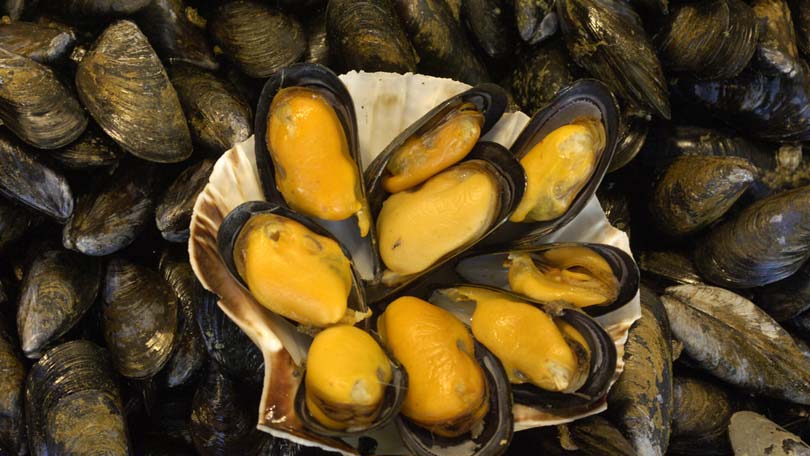
Mussels are a seafood delicacy that many individuals enjoy and are eager to order whenever they find them on a menu. They can be prepared in a number of ways steamed, baked, grilled, or garnished with fancy sauces. Some people prefer them plain and simple while others enjoy more elaborate mussel recipes.
Some fans of this shellfish also enjoy preparing them at home while others aren’t quite sure how to go about choosing mussels and readying them for consumption by themselves and their guests. Once you learn how to accomplish a few simple steps, however, you can enjoy mussels both at home and when you’re eating out.
Mussels are a very simple mollusk. They live in the sea, attached by their ‘beard’ to whatever they’re growing upon. They feed entirely on plankton and spit sea water in and out all day long, which is how they filter their food and nutrients.
In Europe, they’ve been cultivating mussels for nearly a millennium and history shows that these mollusks have been a food source for tens of thousands of years. They’re an excellent source of B & C vitamins, amino acids, Omega 3 fatty acids, and important minerals including iron, manganese, phosphorus, potassium, selenium and zinc. They are also naturally low in sodium and saturated fats.
Buying Mussels
Mussels do tend to get some negative press because consuming a ‘bad’ one can make you very sick for a day or so. That’s why it’s necessary to follow some simple rules when it comes to choosing mussels for at-home consumption.
- Consider carefully where you will buy your mussels. If a supermarket is your first choice, walk around the seafood department first. Does it smell fishy? If so, you may want to reconsider. Good fish doesn’t smell. It may be better to go to a fishmonger at a farmer’s market or other similar establishment. Their inventory tends to turn over more quickly. If you have favorite restaurants that serve mussels, ask them where they buy their mussels.
- Uncooked mussels are ALWAYS sold live. They should be unbroken (throw away the broken ones), shiny, and most of all closed. If you see that one is slightly open, tap on it. If it closes promptly, it’s okay to eat. If not, throw it away. it’s dead. Again, if they smell bad, they probably are bad, so be sure to take a whiff before taking them home.
- Mussels bought at a market or fishmonger have already been purged for sand, so it’s okay to put them in clean, fresh water when you get home. If you’ve harvested them yourself, you’ll need to soak them in salt water. (1 cup salt to 3 cups water)’ Some chefs suggest you add a handful of cornmeal, which will clean the stomach and help purge the sand.
Cleaning, Storing, and Preparation for Cooking
The careful cleaning and storing of the mussels will help you avoid any situations that might make you or your guests sick with intestinal problems. Just follow a few simple steps for trouble-free cleaning of these mollusks.
- If you are using farmed mussels, such as those you get at the grocery store or fishmonger, you’ll just need to rinse them under cold water several times. If you see any grit on the outside, scrub them with a stiff brush. Wild mussels will have to be scrubbed thoroughly to remove sand and barnacles and the beard will also need to be removed. Do this by pulling on it or cutting it off with a sharp knife. The wild mussels can be rinsed in tap water but do not leave them sitting in this water.
- If you aren’t going to cook the mussels immediately, you’ll need to store them properly. Clean them, place them in a bowl, and cover them with a damp towel. Once you’ve done this, they can be refrigerated for 2 to 3 days though it’s always most desirable to cook them as soon after purchase as possible.
- If you want to shuck them before you cook them, after you’ve rinsed or cleaned them, hold the mussel over a bowl and insert a clam knife (or another type of NON-SHARP knife) between the top and bottom shell to cut the hinge. Liquid will pour out into the bowl. Open the shell completely and slide the knife between the mussel and the shell to detach it. The mussel is now ready to be cooked. If you’re not cooking shucked mussels immediately, store them in the refrigerator in a covered bowl of water or their own liquid for up to 2 days.
- Mussels that are to be cooked in their shells just need to be cleaned thoroughly and should not be opened before cooking.
Cooking Mussels
There are myriad ways to prepare mussels but you’ll find that most restaurants serve them in the shell and the diner gets to do the shucking themselves. Sometimes they cook them and then remove the meat for use in a particular recipe. Here are some simple ways to cook mussels at home.
- Steaming‘ ‘ The most common way to prepare mussels, this is generally done using a small amount of water, white wine, or both. Place about 1 cup of broth per pound of mussels in a large saucepan. Add the mussels, cover the pan, and bring to a boil. When steam is released from under the lid, reduce the heat and simmer. At this point, the mussels should begin to open. It usually takes 5 to 7 minutes. If possible, remove each one as it opens to ensure great flavor and exact doneness. Serve in the shells with the strained broth poured over them. Throw away any unopened mussels.
- Grilling or baking‘ ‘ Steam the mussels, discarding any unopened ones. Open the shells completely and throw away the empty side. Place the side with the meat on a baking pan and drizzle with olive oil, desired seasonings, and some breadcrumbs. Bake at 350 degrees until golden brown on top, usually about 10 minutes or less.
- Any uneaten cooked mussels can be placed in a freezer bag or airtight container and stored for up to 3 months. Remove the shells before storing. If you want to eat cooked mussels a day or two later, they can be refrigerated but be sure to remove the shells, cover them with their own liquid, and store in an airtight container. If you don’t eat them within 2 days of cooking, discard them.





